Finish Line Transmissions 4l60e Build Up Thread
#1
Thread Starter
FormerVendor
iTrader: (1)
Joined: Sep 2005
Posts: 6,617
Likes: 1
From: Wood Dale, Illinois
I wanted to take some time to show you guy's some of the things that we do at Finish Line Transmissions aka FLT. This thread will consist of a build from our facility on one of our level 4 4l60e transmissions with a bunch of pictures and also a few video's. I hope that you enjoy it. This whole project for me started a while back when I had a customer come in that asked if he could take some pictures while at the shop picking up his trans. He started a thread on another forum that really took off and seem to get a great viewing from many car enthusiasts. His pictures kinda of got me going and I wanted share more of what we at FLT are all about in his thread. Chuck and I figured as sponsors this info would be good for the members of this site as well. Not only to get to see what we are all about but maybe learn a thing or two about your transmissions. Here is the original post from that thread to give you a little pretext from 99Hawk262. 10-18-07 He has told his story here and took some pictures of the new trans and also his old trans being torn down. Enjoy this first part of the thread. Vince
"
"
"
This all started when I blew my tranny two weeks ago. I started researching my options and looking at the different sponsors as well as local builders. I had looked into one local guy that's supposed to be pretty good, but he wouldn't tell me what he used in his units. He just told me to pay up and I'd have a good tranny. Sorry, but I like to know what I'm paying for.
Enter Vince at FLT. From the beginning, he's taken time out of his schedule to answer all my questions and respond to all my concerns about these trannies. I've made numerous phone calls and he always answers or gets back to me within hours. And of course their 10% off sale was the icing on the cake. So I made arrangements to pick up my new tranny and drop off my old one since I'd be in the area.
Enter wow factor!! I arrived when they opened this past Tuesday morning and got to meet both Vince and Chuck. They had my new tranny warming up on their dyno, so while we were waiting they took me around the shop and showed me everything! They showed me where they do their machine work, where they keep all the new parts, they even showed me their performance components compared to stock components. I was blown away. They showed me everything that went in to my tranny. I looked at the web page, and they don't list half the goodies that these trannies get.
Enter dyno time! That machine is amazing. They showed me how they can adjust line pressure, then ran my tranny through shift cycle three separate times at low throttle, half throttle and full throttle. It was really neat to see it shifting when he commanded it to. Very smooth and lightning fast!
After all this, I was feeling very good about my purchase and thinking this is as good as it gets. Wrong.....Vince offered to tear apart my old tranny so we could see how it failed! I couldn't believe this. In about ten minutes time, he had pulled it apart and inspected every nook and cranny. He showed me typical failure points and what they do to improve on them. He told me my old tranny failed basically because of improper assembly. Not being familiar with internal tranny parts, hopefully Vince will chime in and explain it better than I did. He showed me the failure area and it made perfect sense, but I can't remember all the jargon . I got to see a unit that's in for a refresh that has 4 years and ~650 horsepower on it. The internals looked pretty damn new to my untrained eye. Vince showed me some components that were worn, but they all looked way better than my old tranny internals.....and my old tranny went in this past January.
. I got to see a unit that's in for a refresh that has 4 years and ~650 horsepower on it. The internals looked pretty damn new to my untrained eye. Vince showed me some components that were worn, but they all looked way better than my old tranny internals.....and my old tranny went in this past January.
In conclusion, I got to spend 2 hours with Vince and Chuck and see one of the neatest operations I've ever seen. Those guys take their trannies very seriously and it shows. I've never been treated like that as a customer and I must say it has left a lasting impression. I wish I had bought from them a long time ago. My wife was with me, and normally she could care less about this stuff, but Vince sparked her interest and answered all her questions too. She was almost as excited as me when we left. It was an awesome experience and FLT has nailed it with their customer service. I'll post a review once the tranny is in, but after seeing it on the dyno I can already tell it's going to perform flawlessly.
My hats off to both Chuck and Vince. You have quite an operation and it's pretty obvious to me now why so many claim you are the best in the business. Thank you both so much for an amazing and very educational experience. I'll be in touch! Here's all the pictures I took.
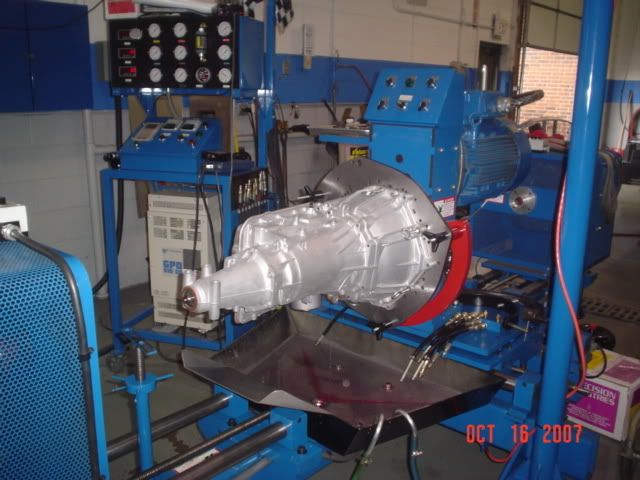
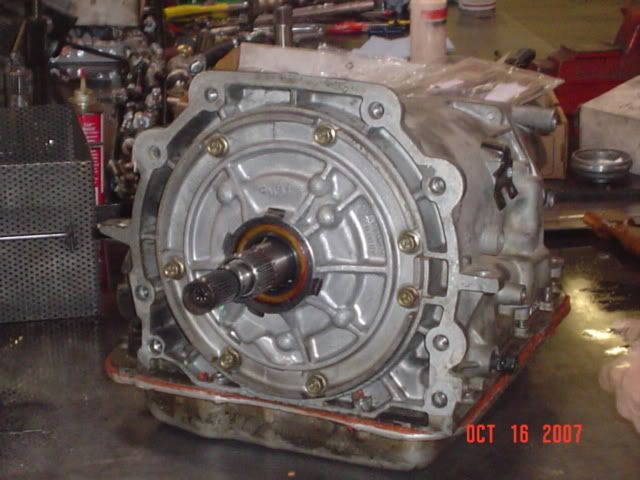
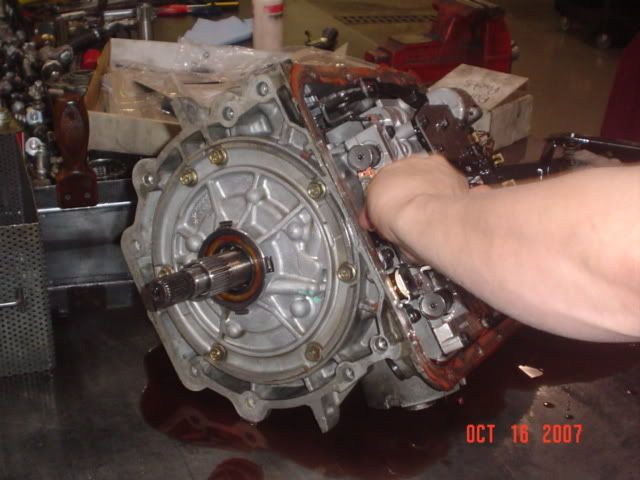

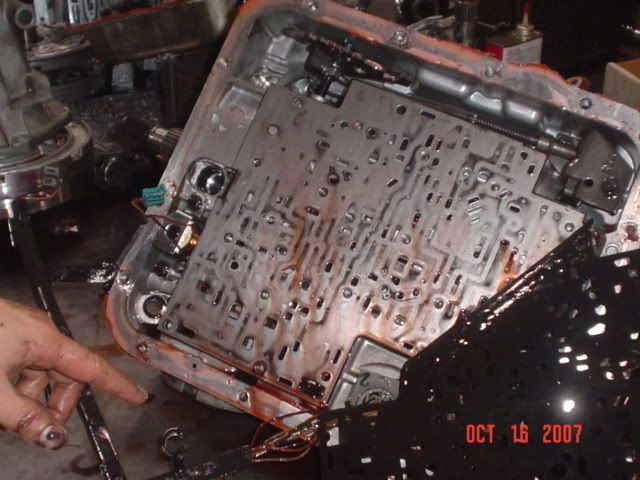
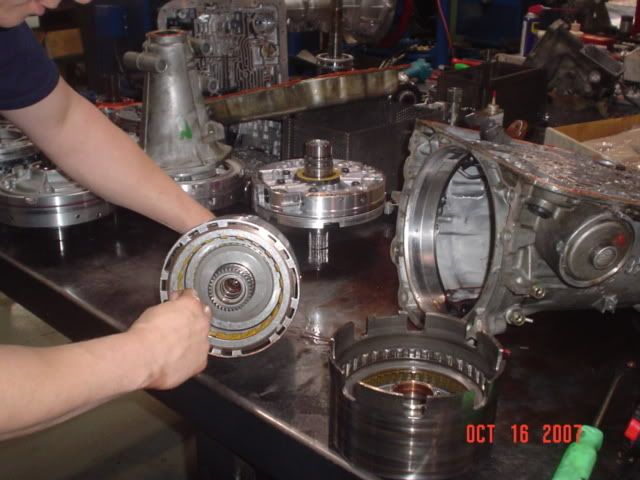
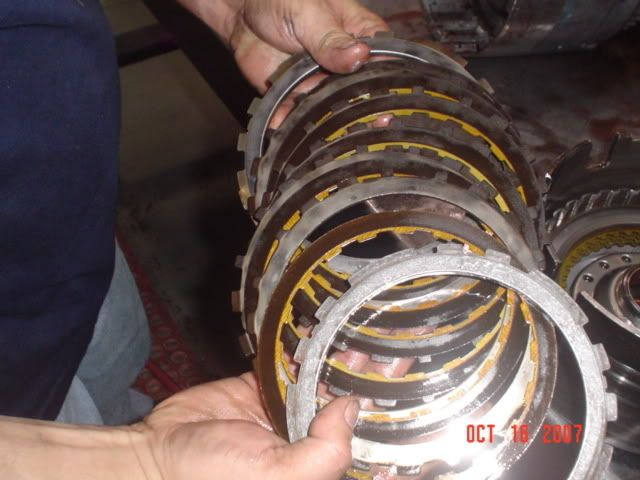

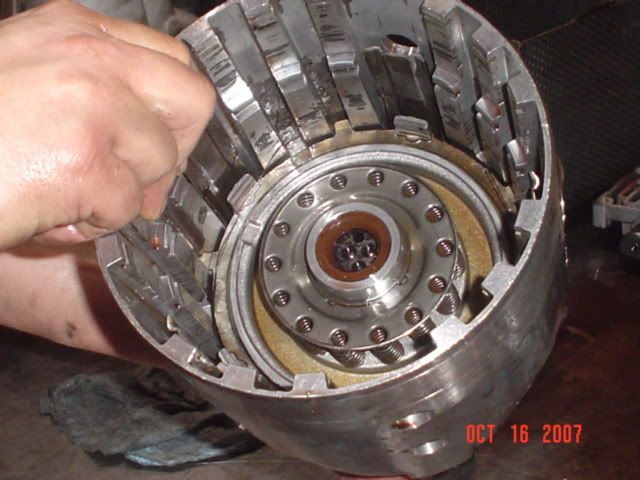
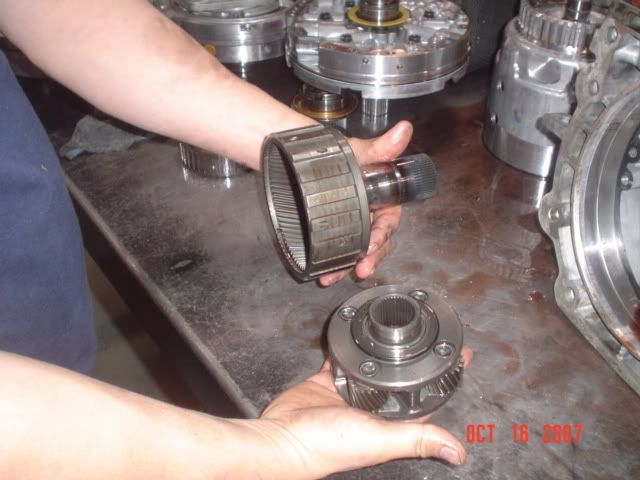
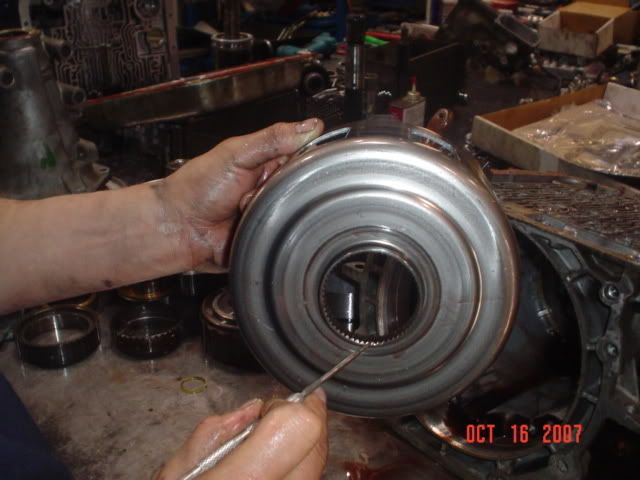
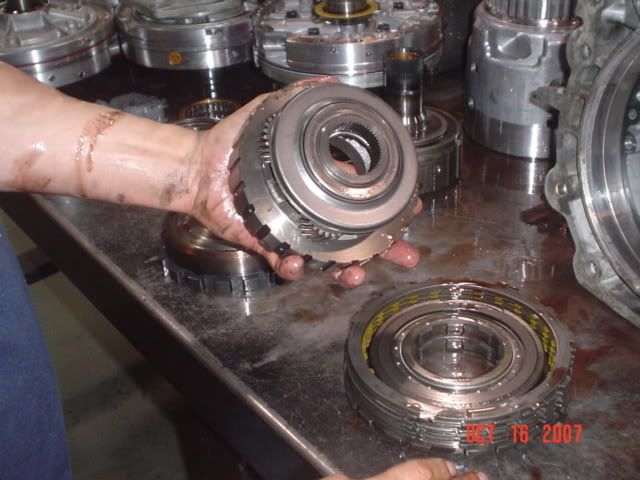
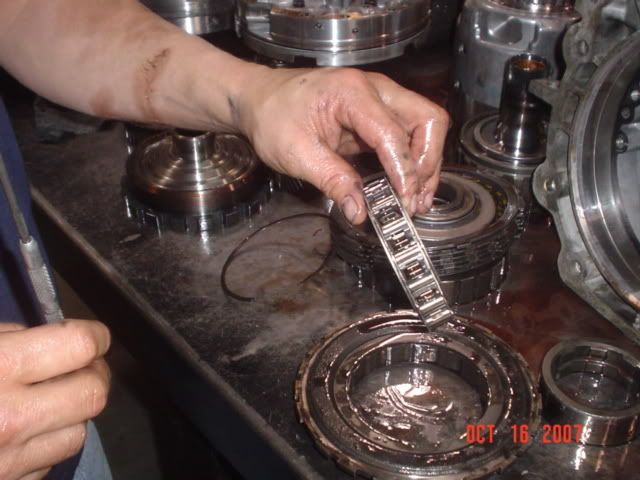


Enter Vince at FLT. From the beginning, he's taken time out of his schedule to answer all my questions and respond to all my concerns about these trannies. I've made numerous phone calls and he always answers or gets back to me within hours. And of course their 10% off sale was the icing on the cake. So I made arrangements to pick up my new tranny and drop off my old one since I'd be in the area.
Enter wow factor!! I arrived when they opened this past Tuesday morning and got to meet both Vince and Chuck. They had my new tranny warming up on their dyno, so while we were waiting they took me around the shop and showed me everything! They showed me where they do their machine work, where they keep all the new parts, they even showed me their performance components compared to stock components. I was blown away. They showed me everything that went in to my tranny. I looked at the web page, and they don't list half the goodies that these trannies get.
Enter dyno time! That machine is amazing. They showed me how they can adjust line pressure, then ran my tranny through shift cycle three separate times at low throttle, half throttle and full throttle. It was really neat to see it shifting when he commanded it to. Very smooth and lightning fast!
After all this, I was feeling very good about my purchase and thinking this is as good as it gets. Wrong.....Vince offered to tear apart my old tranny so we could see how it failed! I couldn't believe this. In about ten minutes time, he had pulled it apart and inspected every nook and cranny. He showed me typical failure points and what they do to improve on them. He told me my old tranny failed basically because of improper assembly. Not being familiar with internal tranny parts, hopefully Vince will chime in and explain it better than I did. He showed me the failure area and it made perfect sense, but I can't remember all the jargon
 . I got to see a unit that's in for a refresh that has 4 years and ~650 horsepower on it. The internals looked pretty damn new to my untrained eye. Vince showed me some components that were worn, but they all looked way better than my old tranny internals.....and my old tranny went in this past January.
. I got to see a unit that's in for a refresh that has 4 years and ~650 horsepower on it. The internals looked pretty damn new to my untrained eye. Vince showed me some components that were worn, but they all looked way better than my old tranny internals.....and my old tranny went in this past January. In conclusion, I got to spend 2 hours with Vince and Chuck and see one of the neatest operations I've ever seen. Those guys take their trannies very seriously and it shows. I've never been treated like that as a customer and I must say it has left a lasting impression. I wish I had bought from them a long time ago. My wife was with me, and normally she could care less about this stuff, but Vince sparked her interest and answered all her questions too. She was almost as excited as me when we left. It was an awesome experience and FLT has nailed it with their customer service. I'll post a review once the tranny is in, but after seeing it on the dyno I can already tell it's going to perform flawlessly.
My hats off to both Chuck and Vince. You have quite an operation and it's pretty obvious to me now why so many claim you are the best in the business. Thank you both so much for an amazing and very educational experience. I'll be in touch! Here's all the pictures I took.















#2
Thread Starter
FormerVendor
iTrader: (1)
Joined: Sep 2005
Posts: 6,617
Likes: 1
From: Wood Dale, Illinois
I would like to show you what makes FLT one of the best on the market. We put more in our transmissions then most do and spend money were others save it for themselves. There is no cutting corners when it comes to our customers. You deserve it and it is that simple.
1. All transmissions come Dyno tested. Here is the real world photo of the machine we use. This insures us that when you get them they work. No excuses. 100% satisfaction guarantee.

2. All units come complete as a bolt in application. These units are shipped with a bell and tail. As you can see in this photo they are literally new. All you need to do is install them. No BS for the installer to do other than put it in. We feel you pay for 100% of a transmission and that is exactly what we give you.

3. No need to swap tail housings and have to put a new bushing and seals in it. It's ready to go and already installed. Some companies do not supply you with this because it only cost them more money. We feel that all new transmissions require it and you as the customer deserve it.

4. All units come with the correct bell housing installed. Not making the installer do it. These bolts that hold this bell on can be very difficult to get out and often strip out. Once again giving you 100% of the transmission and not worried about saving money for ourselves on parts.

5. All units come with the proper cooler fittings. As you can see they are new. Old fittings can leak and cause your new trans to fail due to lack of oil. Once again giving the installer 100% of the transmission.

6. All units come with the proper linkage shafts in them. I get calls all the time from guy's that buy rebuilt units with the wrong ones installed. Their shifters do not line up properly or will not work at all.

7. All units come with valve bodies that have been fully disassemble and checked for proper tolerances. It's the only way to do it in my opinion. These valve bodies come with the trans go hd-2 kit installed. Not a low budget in house kit that costs a couple dollars. We spend money on our units and give it right back to you.

8. All units come with new solenoids and internal harnesses installed on the valve body. Old electronics could be the reason why the last trans failed. We like to eliminate the chance of failure. Once again giving you more for your money.

9. All units come with new clutches and bands. Not just what came out of the core that we built for you. Most companies reuse these.




10. All transmissions come with newly refreshed pumps. Surfaced machined with new internal components and new oversize pressure regulator valves. We do this to eliminate all cross leaks greatly reducing transmission failures.

11. All units come with new upgraded FLT beast sun shells. This is not a normal beast shell in our level 4 and 5 builds. It comes with a bearing and sleeve for added quality/strength.

12. All units come with new wide bushing were available. This gives your transmission added strength and support.

There are many more things that we do. Take a look at our build sheets and compare them to the competition when purchasing a unit. There is a lot of marketing scams out there that make things look better then they really are. At FLT we fully go through your unit and do not cut corners in order to save us money. I personally guarantee it. Vince
Here are a couple video clips I put together for you guy's to see our Dyno in action. This trans is one of our level 5 4l60E transmissions. With the use of this machine it allows us to give you the quality you deserve. It really is a quality control/research and development tool that we use to insure that when you get your transmission it works. These are pulls at different amounts of pressure.
The first one is at a 125psi.

This is a pull at 150psi.

This is a pull at 185psi.

This pull is at max pressure.

1. All transmissions come Dyno tested. Here is the real world photo of the machine we use. This insures us that when you get them they work. No excuses. 100% satisfaction guarantee.

2. All units come complete as a bolt in application. These units are shipped with a bell and tail. As you can see in this photo they are literally new. All you need to do is install them. No BS for the installer to do other than put it in. We feel you pay for 100% of a transmission and that is exactly what we give you.

3. No need to swap tail housings and have to put a new bushing and seals in it. It's ready to go and already installed. Some companies do not supply you with this because it only cost them more money. We feel that all new transmissions require it and you as the customer deserve it.

4. All units come with the correct bell housing installed. Not making the installer do it. These bolts that hold this bell on can be very difficult to get out and often strip out. Once again giving you 100% of the transmission and not worried about saving money for ourselves on parts.

5. All units come with the proper cooler fittings. As you can see they are new. Old fittings can leak and cause your new trans to fail due to lack of oil. Once again giving the installer 100% of the transmission.

6. All units come with the proper linkage shafts in them. I get calls all the time from guy's that buy rebuilt units with the wrong ones installed. Their shifters do not line up properly or will not work at all.

7. All units come with valve bodies that have been fully disassemble and checked for proper tolerances. It's the only way to do it in my opinion. These valve bodies come with the trans go hd-2 kit installed. Not a low budget in house kit that costs a couple dollars. We spend money on our units and give it right back to you.

8. All units come with new solenoids and internal harnesses installed on the valve body. Old electronics could be the reason why the last trans failed. We like to eliminate the chance of failure. Once again giving you more for your money.

9. All units come with new clutches and bands. Not just what came out of the core that we built for you. Most companies reuse these.




10. All transmissions come with newly refreshed pumps. Surfaced machined with new internal components and new oversize pressure regulator valves. We do this to eliminate all cross leaks greatly reducing transmission failures.

11. All units come with new upgraded FLT beast sun shells. This is not a normal beast shell in our level 4 and 5 builds. It comes with a bearing and sleeve for added quality/strength.

12. All units come with new wide bushing were available. This gives your transmission added strength and support.

There are many more things that we do. Take a look at our build sheets and compare them to the competition when purchasing a unit. There is a lot of marketing scams out there that make things look better then they really are. At FLT we fully go through your unit and do not cut corners in order to save us money. I personally guarantee it. Vince
Here are a couple video clips I put together for you guy's to see our Dyno in action. This trans is one of our level 5 4l60E transmissions. With the use of this machine it allows us to give you the quality you deserve. It really is a quality control/research and development tool that we use to insure that when you get your transmission it works. These are pulls at different amounts of pressure.
The first one is at a 125psi.

This is a pull at 150psi.

This is a pull at 185psi.

This pull is at max pressure.

Last edited by FLT; 12-26-2007 at 09:06 AM.
#4
Thread Starter
FormerVendor
iTrader: (1)
Joined: Sep 2005
Posts: 6,617
Likes: 1
From: Wood Dale, Illinois
Here are some pictures the beginning of the trans being assembled. This first picture is of the case bushing installed.

Here are a couple others.



Picture is of the low/reverse piston with the seals installed.

Picture with of the low/reverse piston, spring cage and snap ring.

Picture of the piston in the case ready to be installed. This is the tool that I use to lightly tap it into place.

This picture is with the piston in the case and the spring cage ready to be compressed.

This is the tool that is used to compress the spring cage.

This is how the spring cage is compressed in order to install the snap ring that retains the spring cage.

This is what it looks like when it is done.

More photo's coming of the assemblies being installed.

Here are a couple others.



Picture is of the low/reverse piston with the seals installed.

Picture with of the low/reverse piston, spring cage and snap ring.

Picture of the piston in the case ready to be installed. This is the tool that I use to lightly tap it into place.

This picture is with the piston in the case and the spring cage ready to be compressed.

This is the tool that is used to compress the spring cage.

This is how the spring cage is compressed in order to install the snap ring that retains the spring cage.

This is what it looks like when it is done.

More photo's coming of the assemblies being installed.
#5
Thread Starter
FormerVendor
iTrader: (1)
Joined: Sep 2005
Posts: 6,617
Likes: 1
From: Wood Dale, Illinois
Here are some added photo's of the back half of the trans being assembled. The next step is to get the rear planet assembly ready and get it installed in the case. As you can see in the pictures in post #72 we have installed our low and reverse piston assembly. The next parts to look at are the rear ring gear and the ring gear support. This first picture is of the support. Note the condition of the bushing surface and also the splined area's of this part. They need to be like new in condition. If they are badly worn, we will replace it with another one. Here is the photo.

The next piece is the rear ring gear. We make sure that this gear is clean and free of debris. The snap ring groove loves to collect debris. Some builders never take this apart. That is poor building practice IMO. We make sure to view and clean every part in these transmissions. Also making sure that the gear itself is not chipped or damaged in any way. Here is a photo of a ring gear ready to be installed.

Here is a picture of the two pieces assembled with the snap ring.

The next part to address after cleaning it in solvent is the rear planet. We inspect the gears for pitting, chips and looseness of the pinion gears. See where my fingers are, this is where the gear needs to be checked for looseness/wobble. Here is a picture of the planet.

The next photo is of the planet with the torrington bearing already installed.

Next is to assemble the planet and the ring gear assembly.

I always make sure to lightly grease bushing surfaces of hard parts and also the bushing itself.

The next step is to get the low reverse clutch pack ready to be installed. The wave plate is the first plate that will be installed into the case. This is followed with a steel and a clutch until all 5 plates are in the case. Here is a photo of the pack before it is installed.

Next we will install the planet assembly into the case.

Then the wave plate, steels and frictions are installed.

The following part is an anti-rattle clip. We as always inspect this clip to make sure that it has not collapsed and is like new in condition. Here is a picture of it.

I always grease this clip into place in the case.

The next part to be installed will be the low roller support. Here is the photo.

The next thing to do is to install new low roller and the snap ring to keep it in place.

The next step is to install the low roller race. This race has been modified for use with our FLT beast sun shell kit.

When fully installed this is what it looks like.

The next step is to install it into the case. Here is the photo of the complete low roller assembly assembled into the case.

Next step is to install the snap ring into the case. It is important that it be installed in the correct location.

Here a photo with the snap ring seated in the case and also the low roller seated on the planetary.

Next we will assemble our FLT/beast sun shell package.

The next piece is the rear ring gear. We make sure that this gear is clean and free of debris. The snap ring groove loves to collect debris. Some builders never take this apart. That is poor building practice IMO. We make sure to view and clean every part in these transmissions. Also making sure that the gear itself is not chipped or damaged in any way. Here is a photo of a ring gear ready to be installed.

Here is a picture of the two pieces assembled with the snap ring.

The next part to address after cleaning it in solvent is the rear planet. We inspect the gears for pitting, chips and looseness of the pinion gears. See where my fingers are, this is where the gear needs to be checked for looseness/wobble. Here is a picture of the planet.

The next photo is of the planet with the torrington bearing already installed.

Next is to assemble the planet and the ring gear assembly.

I always make sure to lightly grease bushing surfaces of hard parts and also the bushing itself.

The next step is to get the low reverse clutch pack ready to be installed. The wave plate is the first plate that will be installed into the case. This is followed with a steel and a clutch until all 5 plates are in the case. Here is a photo of the pack before it is installed.

Next we will install the planet assembly into the case.

Then the wave plate, steels and frictions are installed.

The following part is an anti-rattle clip. We as always inspect this clip to make sure that it has not collapsed and is like new in condition. Here is a picture of it.

I always grease this clip into place in the case.

The next part to be installed will be the low roller support. Here is the photo.

The next thing to do is to install new low roller and the snap ring to keep it in place.

The next step is to install the low roller race. This race has been modified for use with our FLT beast sun shell kit.

When fully installed this is what it looks like.

The next step is to install it into the case. Here is the photo of the complete low roller assembly assembled into the case.

Next step is to install the snap ring into the case. It is important that it be installed in the correct location.

Here a photo with the snap ring seated in the case and also the low roller seated on the planetary.

Next we will assemble our FLT/beast sun shell package.
#6
Thread Starter
FormerVendor
iTrader: (1)
Joined: Sep 2005
Posts: 6,617
Likes: 1
From: Wood Dale, Illinois
The next step is to replace the rear sun gear bushing using a wide bushing for the beast sun shell. This is required to add support for the shell and is recommended by the manufacturer. I believe the reason is because the shell is heavier. Here is a picture to show the difference in the two bushings.

I always look closely at the teeth of the gear (bottom) and also the splines that will be pressed into the the sun shell(top). They need to not show any signs of wear. Otherwise unacceptable gear train noise can occur. Here is a close up photo.

The next photo is of the stock beast shell.

Here is a photo to show you what happens to the factory shell. The OEM shell on the left is obviously broken. You can also see that the beast shell is much thicker in this area.

Here is a photo to show you what the oem washer looks like. This washer would normally be installed on the low roller race and would only be used with an oem shell. When using the beast shell it would be discarded.

Here is the photo with it on the race.

Here is a picture of the washer that is supplied with the beast shell.

Here is a photo with it the washer installed. We only use this setup on our level 3 builds.

On our level 4 and 5 builds we use a bearing instead of the washer. Here is a photo of what our FLT beast shell looks like with the bearing installed.

In order to install a bearing here it requires that we install a sleeve to support it. It also requires the low roller race be modified. Here is a photo of the sleeve for the shell.

Here is a photo of the factory race.

Here is a photo of our modified race. It has been decked and bored.

When it is all done we press the sun gear in and this is what gets installed next in our level 4 and 5 builds.

Here is the photo with our FLT beast shell installed.

I will post up some more photo's of the reaction shaft and output shaft differences to complete the rear half install. Feel free to post a question or a comment here in this thread.

I always look closely at the teeth of the gear (bottom) and also the splines that will be pressed into the the sun shell(top). They need to not show any signs of wear. Otherwise unacceptable gear train noise can occur. Here is a close up photo.

The next photo is of the stock beast shell.

Here is a photo to show you what happens to the factory shell. The OEM shell on the left is obviously broken. You can also see that the beast shell is much thicker in this area.

Here is a photo to show you what the oem washer looks like. This washer would normally be installed on the low roller race and would only be used with an oem shell. When using the beast shell it would be discarded.

Here is the photo with it on the race.

Here is a picture of the washer that is supplied with the beast shell.

Here is a photo with it the washer installed. We only use this setup on our level 3 builds.

On our level 4 and 5 builds we use a bearing instead of the washer. Here is a photo of what our FLT beast shell looks like with the bearing installed.

In order to install a bearing here it requires that we install a sleeve to support it. It also requires the low roller race be modified. Here is a photo of the sleeve for the shell.

Here is a photo of the factory race.

Here is a photo of our modified race. It has been decked and bored.

When it is all done we press the sun gear in and this is what gets installed next in our level 4 and 5 builds.

Here is the photo with our FLT beast shell installed.

I will post up some more photo's of the reaction shaft and output shaft differences to complete the rear half install. Feel free to post a question or a comment here in this thread.
#7
Thread Starter
FormerVendor
iTrader: (1)
Joined: Sep 2005
Posts: 6,617
Likes: 1
From: Wood Dale, Illinois
Here is where I left off with the beast shell installed.

The next piece in the trans for us to look at is the reaction shaft. There are two different styles for these transmissions. The first style is the washer style which in this next photo is piece on the right. The piece on the left is the bearing style. I prefer the bearing style and it is a mandatory piece in all of our level 5 builds. Theses pieces have been polished and are ready for inspection. I look closely at the splined areas of these parts to look for wear and must be like new in order to be used. The bushings in these parts are in most cases are replaced. These bushing are still the originals. Here is the photo.

Next we will inspect the front ring gear for wear. The area where the reaction shaft and the snap ring is installed love to collect dirt and debris. It is good practice to make sure that the part is not only good to use but is also very clean. We also want to make sure that the area where the 3-4 clutch rides is in good condition as well. Here is the photo.

The next step is to assemble the reaction shaft and the front ring gear. Note that the bearing and the snap ring have already been installed in it's proper location. Here is the photo.

If you were not using the bearing style reaction shaft. The washer that would be used instead would be installed and greased here.

The next step is to inspect the front planet. Once again we need to look at the splines of the part where the output shaft will ride. Also the pinion gears need to be inspected for looseness/wobble and pitting. Here is a photo of the front planet.

I always make sure to apply some assembly grease to the areas where bushings will ride. Also I will apply grease to the bushings themselves.


Here is the photo of the plant and reaction shaft assembled.

Here is the photo of the full assembly being installed.

Now we are ready to install our output shaft. Here is the photo.

Here is a photo of the output shaft for a 2wd vehicle. It has been polished and is ready to go.

Note the location of the snap ring groove and also the surfaces where the bushing will ride. They are in perfect condition. Here is the photo.

The next step is to install the output shaft and install the snap ring. Here is the photo.

After all pieces are in place, I make sure to grease the area where the front sun gear bushing will ride.

Here it is, the rear half of the trans is now built.

I hope you guy's are enjoying the photo's. Feel free to post a comment or a question here. I will start the next portion of the front assemblies. Vince

The next piece in the trans for us to look at is the reaction shaft. There are two different styles for these transmissions. The first style is the washer style which in this next photo is piece on the right. The piece on the left is the bearing style. I prefer the bearing style and it is a mandatory piece in all of our level 5 builds. Theses pieces have been polished and are ready for inspection. I look closely at the splined areas of these parts to look for wear and must be like new in order to be used. The bushings in these parts are in most cases are replaced. These bushing are still the originals. Here is the photo.

Next we will inspect the front ring gear for wear. The area where the reaction shaft and the snap ring is installed love to collect dirt and debris. It is good practice to make sure that the part is not only good to use but is also very clean. We also want to make sure that the area where the 3-4 clutch rides is in good condition as well. Here is the photo.

The next step is to assemble the reaction shaft and the front ring gear. Note that the bearing and the snap ring have already been installed in it's proper location. Here is the photo.

If you were not using the bearing style reaction shaft. The washer that would be used instead would be installed and greased here.

The next step is to inspect the front planet. Once again we need to look at the splines of the part where the output shaft will ride. Also the pinion gears need to be inspected for looseness/wobble and pitting. Here is a photo of the front planet.

I always make sure to apply some assembly grease to the areas where bushings will ride. Also I will apply grease to the bushings themselves.


Here is the photo of the plant and reaction shaft assembled.

Here is the photo of the full assembly being installed.

Now we are ready to install our output shaft. Here is the photo.

Here is a photo of the output shaft for a 2wd vehicle. It has been polished and is ready to go.

Note the location of the snap ring groove and also the surfaces where the bushing will ride. They are in perfect condition. Here is the photo.

The next step is to install the output shaft and install the snap ring. Here is the photo.

After all pieces are in place, I make sure to grease the area where the front sun gear bushing will ride.

Here it is, the rear half of the trans is now built.

I hope you guy's are enjoying the photo's. Feel free to post a comment or a question here. I will start the next portion of the front assemblies. Vince
Trending Topics
#8
Thread Starter
FormerVendor
iTrader: (1)
Joined: Sep 2005
Posts: 6,617
Likes: 1
From: Wood Dale, Illinois
I am starting the build of the front half of the transmission. This next set of photo's is going to show how we build our input drums in our level 4 and 5 units. This will be a segment on how each and every sleeved drum gets done here at FLT. This drum in my opinion is a very good upgrade and makes this trans much stronger. The idea behind the sleeved drum is that it will keep the aluminum drum from expanding and not allowing the input shaft to float in the drum. We have seen this many times in the past and also in cores that we tear down. Most shops never remove these shafts and for us it is mandatory. This is a picture of where we left off.

Here are some photo's of the drum completely disassembled. All surfaces have been inspected, cleaned and critical surfaces have been polished ready for assembly.


We always pay close attention to the surfaces where the input shaft will be pressed in and also that all splined areas are acceptable. This first picture is where the shaft will be pressed in.

Here is a photo of the area where the reverse input clutches will ride. Also note the area where the feed holes will be aligned and the quality of the surface.

Now we take a look at the inside of the drum. We are looking for bad ridges where the steels will ride. Slight wear marks are ok and in most cases the drum is reusable. Here is a photo of the inside of the drum.

Here is the pieces that will be installed next. They include the drum, sleeve and the input shaft.

Now we are ready to install the sleeve in our drum. The first thing to do is to apply a thin layer of lock tight to the drum and the sleeve. Then line up the lube hole slot for the overrun clutch. Here are a couple photo's.


Now that we have the sleeve in place it is time to put it in the press. In most cases the arbor press will work for the install of the sleeve. If not we have larger press that works as well. I will make sure to support the drum when pressing on the sleeve. This will assure us that it will not get cracked or stressed during the process. Here is a photo of the setup on the press.

After getting things lined up, I use an old bearing race to press the new sleeve on the drum.


Then we press the sleeve down. They go on with quite a bit of resistance and that is what we are after. Here are a couple photo's of the sleeve being pressed on. One from the top.

Another that I got a little creative with. Thought it was a cool picture.

The drum is now sleeved. Here is the photo.

Next we will install the shaft.

Here are some photo's of the drum completely disassembled. All surfaces have been inspected, cleaned and critical surfaces have been polished ready for assembly.


We always pay close attention to the surfaces where the input shaft will be pressed in and also that all splined areas are acceptable. This first picture is where the shaft will be pressed in.

Here is a photo of the area where the reverse input clutches will ride. Also note the area where the feed holes will be aligned and the quality of the surface.

Now we take a look at the inside of the drum. We are looking for bad ridges where the steels will ride. Slight wear marks are ok and in most cases the drum is reusable. Here is a photo of the inside of the drum.

Here is the pieces that will be installed next. They include the drum, sleeve and the input shaft.

Now we are ready to install the sleeve in our drum. The first thing to do is to apply a thin layer of lock tight to the drum and the sleeve. Then line up the lube hole slot for the overrun clutch. Here are a couple photo's.


Now that we have the sleeve in place it is time to put it in the press. In most cases the arbor press will work for the install of the sleeve. If not we have larger press that works as well. I will make sure to support the drum when pressing on the sleeve. This will assure us that it will not get cracked or stressed during the process. Here is a photo of the setup on the press.

After getting things lined up, I use an old bearing race to press the new sleeve on the drum.


Then we press the sleeve down. They go on with quite a bit of resistance and that is what we are after. Here are a couple photo's of the sleeve being pressed on. One from the top.

Another that I got a little creative with. Thought it was a cool picture.

The drum is now sleeved. Here is the photo.

Next we will install the shaft.
#9
Thread Starter
FormerVendor
iTrader: (1)
Joined: Sep 2005
Posts: 6,617
Likes: 1
From: Wood Dale, Illinois
Here we are going to make sure to line up the splines for the input drum an the shaft. Notice the double wide spline that centers things.



Next we will use a light amount of lock tight on the area where the feed holes are on both the shaft and the drum. Also put a good bead on the splines of the shaft itself.


Next it will be time to put the shaft in the hole of the drum. Making sure to line it up properly and then tap it down with a rubber mallet or plastic dead blow hammer. It should not go in very far and we are just making sure that there is proper resistance at this point and also that it is seated properly/aligned.

Now we will head to the press. Once again using a large socket to support the drum to avoid any chance of cracking or stressing it. Here are a few photo's of the setup.



The shaft is now installed and here are a few photo's of the finished product of the sleeved drum.



Next we will install the input shaft Teflon seals. These are done by the use of a seal installer and a resizer. Here are some photo's of them being installed and then sized.







I will next do the assembly of the clutches, steels, pistons, spring cages and the input sprag. Stay tuned and enjoy the photo's. Vince



Next we will use a light amount of lock tight on the area where the feed holes are on both the shaft and the drum. Also put a good bead on the splines of the shaft itself.


Next it will be time to put the shaft in the hole of the drum. Making sure to line it up properly and then tap it down with a rubber mallet or plastic dead blow hammer. It should not go in very far and we are just making sure that there is proper resistance at this point and also that it is seated properly/aligned.

Now we will head to the press. Once again using a large socket to support the drum to avoid any chance of cracking or stressing it. Here are a few photo's of the setup.



The shaft is now installed and here are a few photo's of the finished product of the sleeved drum.



Next we will install the input shaft Teflon seals. These are done by the use of a seal installer and a resizer. Here are some photo's of them being installed and then sized.







I will next do the assembly of the clutches, steels, pistons, spring cages and the input sprag. Stay tuned and enjoy the photo's. Vince
#10
Thread Starter
FormerVendor
iTrader: (1)
Joined: Sep 2005
Posts: 6,617
Likes: 1
From: Wood Dale, Illinois
In my last post we left off at the input drum being sleeved and the input shaft being pressed back in the drum. These next photo's will be of the internal pistons, retainers, modified spring cages, seals and 3-4 clutch apply ring being installed.
This first picture is of the sleeved drum ready for the assembly of the internal components.


The first steps that we take are to install the internal seals of the drum. Here are the ones that I am referring to. The top one is the new 3-4 steel bonded apply piston. Bottom left is a oring that seals the forward clutch housing and also the new 3-4 clutch piston. Bottom right seal is a seal used for lube oil from the input shaft to the output shaft. Here is a photo of the seals.

Here is a photo of the lube seal for the two shafts. It gets installed in the input drum here.


The next seal that I will install is the green oring. Here is where it will be installed.

The new 3-4 clutch apply piston is the next to be installed. Here are a couple of photo's.


Next we will install a modified seal installer. This installer has been bored to accommodate for the steel sleeve that we have installed.

Here is a line up of the components that will be assembled into the input drum.

The next step that I will do is to get our spring cages ready to be installed. These are the cages that we will modify with the use of springs from transgo. The idea with these springs is that they are heavier and also will greatly reduce any centrifugal apply at high rpms with the 3-4 clutch/overrun clutch. Here are the factory cages.

As you can see in this photo the 3-4 return spring cage is held together with little hooks. They will need to be bent out of the way in order to get it apart and remove the factory springs. Here are a few photo's.



Here is a photo of the overrun/forward return spring cage. I will first remove the bottom of the cage using a small screw driver. Then I will use a pair of wire cutters to remove the springs from the top portion of the cage.

Here is a photo of both cages fully apart with the new springs that we are going to install.

Here are photos of the 3-4 cage and it's new springs. Note the first picture the springs are tapered and will snap in place.


This first picture is of the sleeved drum ready for the assembly of the internal components.


The first steps that we take are to install the internal seals of the drum. Here are the ones that I am referring to. The top one is the new 3-4 steel bonded apply piston. Bottom left is a oring that seals the forward clutch housing and also the new 3-4 clutch piston. Bottom right seal is a seal used for lube oil from the input shaft to the output shaft. Here is a photo of the seals.

Here is a photo of the lube seal for the two shafts. It gets installed in the input drum here.


The next seal that I will install is the green oring. Here is where it will be installed.

The new 3-4 clutch apply piston is the next to be installed. Here are a couple of photo's.


Next we will install a modified seal installer. This installer has been bored to accommodate for the steel sleeve that we have installed.

Here is a line up of the components that will be assembled into the input drum.

The next step that I will do is to get our spring cages ready to be installed. These are the cages that we will modify with the use of springs from transgo. The idea with these springs is that they are heavier and also will greatly reduce any centrifugal apply at high rpms with the 3-4 clutch/overrun clutch. Here are the factory cages.

As you can see in this photo the 3-4 return spring cage is held together with little hooks. They will need to be bent out of the way in order to get it apart and remove the factory springs. Here are a few photo's.



Here is a photo of the overrun/forward return spring cage. I will first remove the bottom of the cage using a small screw driver. Then I will use a pair of wire cutters to remove the springs from the top portion of the cage.

Here is a photo of both cages fully apart with the new springs that we are going to install.

Here are photos of the 3-4 cage and it's new springs. Note the first picture the springs are tapered and will snap in place.





















